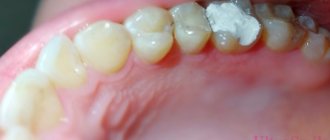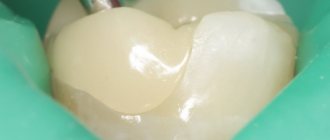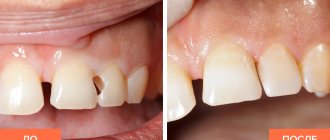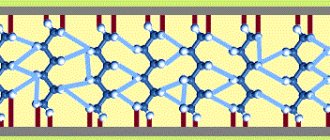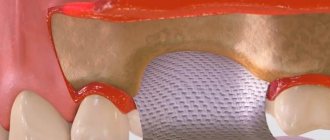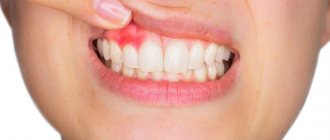The main principle of modern dentistry is the restoration and preservation of teeth, even the most problematic ones. Complex cases require more time than conventional caries filling. Such treatment usually includes several stages, and this requires the installation of a temporary filling.
At the Mitino Dental Center, appointments are conducted by experienced dentists. Our doctors successfully solve the most difficult problems, so before you decide to remove a tooth, try to save it. Make an appointment with us for a consultation and initial examination.
What is a temporary filling and what types does it come in?
This method of treatment is used for deep caries, pulpitis, and also for inflammatory processes in the root canals. A temporary filling means closing a tooth canal with a special compound that provides tightness and protection only for a certain time. This filling can be easily removed to continue the necessary treatment. That is why she is not able to withstand chewing loads for a long time. After completion of treatment, permanent filling must be carried out.
Such fillings have a safe and plastic composition that is easily distributed throughout the tooth cavity and dries quickly. Modern temporary filling material can be of the following types:
- artificial dentin - powder made from kaolin and zinc sulfate, which is diluted with plain water;
- cements – polymer, glass ionomer and zinc phosphate;
- dentin paste is an oil-based composition that contains zinc sulfate cement;
- Vinoxol is a zinc sulfate cement that has good strength;
- Karyosan - available in powder and liquid form.
These compounds have less protection from external influences than filling materials for permanent fillings. The type of paste is selected only by the doctor, based on the purpose and duration of treatment. Some formulations are designed for up to 1 week, while others last for several months.
What is a modern tooth filling?
Almost all of us have had to go to dentistry to restore teeth affected by caries. However, few people think about the characteristics of the materials used and ask the dentist related questions. That is why unpleasant situations can occur associated with the rapid loss of the installed filling, further destruction of the crown part of the tooth and the development of pulpitis.
In this case, the level of professionalism of the attending physician is of no small importance. Only a competent specialist is able to carry out the work efficiently and with minimal risk of pain, as well as guarantee a prolonged result.
So, let's figure out what a tooth filling is and what role it plays in modern dental practice.
First of all, a filling is a material that is distinguished by two important properties: high viscosity and the ability to harden quickly. Its main purpose is to fill the cavity in the crown, which was previously affected by pulpitis or caries. Also, with the help of this composition it is possible to eliminate chips and other enamel defects.
However, if you want to get the desired effect and restore lost functions to the native crown, it is important that the filling on the tooth has a reliable structure. Nowadays, light-curing compositions, which are famous for their impeccable aesthetics and excellent performance properties, are especially popular. Also in wide demand are ceramic bases, which are characterized by increased strength and make it possible to eliminate chipped teeth.
Why do they put a temporary filling?
In cases where there is a pathological process in the root canals, preliminary treatment with various medicinal compounds is required. In order for the medicine to remain in the canal for the required period, it is secured by installing a temporary filling. It also acts as a protective barrier against germs, bacteria and food debris that can get into the cavity of a diseased tooth.
Main indications for temporary tooth closure:
- Isolation of therapeutic antiseptic pad.
- Inflammation of the pulp (pulpitis). For this, arsenic paste is used to destroy the nerve of the tooth.
- Deep caries with damage to dentin.
- Periodontitis.
- Manufacturing of ceramic permanent inlay.
- The need to reschedule treatment.
Sometimes temporary filling is used for diagnostic purposes. If caries has damaged the deep layers, then it is impossible to find out exactly how damaged the pulp is. Therefore, the doctor must observe the tooth to choose the optimal treatment. The absence of pain indicates the vitality of the tooth, which means there is no need to remove the nerve.
Tooth filling: prices
The Elident clinic has established reasonable prices for all types of treatment related to the elimination of carious areas and restoration of the physical and aesthetic characteristics of teeth. That is, if a patient is interested in a tooth filling and its prices, treatment in Moscow can be done inexpensively in our dentistry. In this case, the determining factor is the type of filling base used and the cost of additional materials.
For example, treatment of average caries using the light-curing material Estelite will cost you 4,000 rubles. If you need to pre-install a temporary filling with a medicinal composition, be prepared to pay around 400-500 rubles.
Many people are interested in how much a light-polymer tooth filling itself costs in Moscow. Our cost of light compositions Filtek, Revolution, Vitrimer and Estelite varies from 2200 to 2800 ₽. In case of massive destruction of the natural crown, the doctor may recommend installing a fiberglass or titanium pin. For it you will have to pay 1500-1600 ₽ additionally.
If it is necessary to fill a canal with Forfenan, Metapex and Ahplus pastes, the patient will have to pay about 800 to 1600 rubles, depending on the material chosen.
You can find a list of all related procedures on our website. As for the initial consultation with a specialist and a full calculation of the cost of treatment, both of these services can be obtained from us free of charge.
| Service | Price, ₽. |
| Examination of the patient, calculation of the cost of services | for free |
| Light polymer (Light) filling Estelite | 2800 |
| Light-polymer (Light) filling Vitrimer | 2700 |
| Light polymer (Light) filling Filtek | 2500 |
| Fuji glass ionomer cement | 2200 |
| Light-polymer (Light) filling Revolution (for a crown) | 1800 |
| Treatment of average caries MOD Estelite | 4000 |
| Treatment of average caries MOD Filtek | 3800 |
| Treatment of medium caries MOD Fuji | 3500 |
| Grinding the filling | 350 |
| Temporary filling with Septopak medicinal preparations | 550 |
| Temporary filling (dentin) | 300 |
| Temporary light filling Clip | 400 |
| Fuji insulating gasket, revolutionary | 450 |
| Light polymer therapeutic pad | 450 |
| Fiberglass pin | 1600 |
| Anchor pin | 800 |
| Titanium pin | 1500 |
| Additional surface no more than one Estelite | 800 |
| Additional surface no more than one Filtek | 600 |
| Additional surface no more than one Fuji | 500 |
| Aesthetic restoration of anterior teeth according to class III | 3500 |
| Aesthetic restoration of anterior teeth according to class IV | 3800 |
| Clinical/home whitening | 6500-8500 |
Installing a temporary filling
The decision to perform a temporary tooth filling is made by the dentist after a preliminary examination. X-ray diagnostics are also performed. The main rule is that in case of a purulent lesion, the tooth cavity should remain open. Only after complete elimination of the purulent contents, the tooth is temporarily closed with the installation of a therapeutic lining.
Installation takes no more than 30 minutes. The doctor performs the following manipulations:
- cleaning the canal with an antiseptic solution;
- laying down the medicinal composition (if necessary);
- installation of temporary filling material.
Since the temporary filling takes more time to completely harden, it is not recommended to eat for 2 hours after the procedure. Solid foods should be excluded from the menu for a day.
Important! A temporary filling may break due to exposure to saliva. Therefore, it is important to carefully monitor oral hygiene during the treatment period. Be sure to use antiseptic rinsing solutions.
If pain occurs, consult a doctor immediately!
What factors influence the cost of a tooth filling in Moscow?
For many patients, restoring damaged teeth using photopolymer or ceramic mass is expensive. At the same time, when it becomes necessary to put a filling on a tooth, its final cost may be influenced by the following points:
- Possibility of using high-quality filling compounds;
- The use of modern medicinal materials, which are overpriced;
- Involvement of expensive equipment in the treatment process;
- Participation of dental therapists of the highest category.
As you can see, the desire to undergo effective treatment in comfortable conditions can cost a lot of money. In some cases, several visits are required to place a filling on a tooth. This indicates an increase in the final amount for dental services.
Moreover, when it is necessary to put a filling on a tooth, its cost in Moscow can be determined depending on the stages of treatment. These include:
- Initial visit to the dentist;
- Treatment of the cavity affected by caries;
- Use of medicinal composition;
- Taking an image of the dental roots (if necessary);
- Depulpation;
- Canal treatment: cleaning and shaping;
- Filling channels with a special composition;
- Filling a tooth with a temporary filling;
- Application of material intended for permanent use.
How long does a temporary filling last?
The period depends on the diagnosis and the purpose of the temporary filling. This could be a few days or several months. Approximate terms for which the seal is placed:
- Nerve killing for pulpitis and deep caries - from 1 day to a week. This depends on the composition of the filling material.
- It takes 1–3 weeks to eliminate the inflammatory process in the tooth canal.
- When treating cysts, a temporary filling can last up to 2-3 months.
The decision is made only by the attending physician. But on average, a permanent filling is placed no later than after 10–14 days.
Important! You cannot wear a temporary filling for longer than the period prescribed by your dentist. This can lead to relapse of the pathological process.
Free consultation
Our specialists will conduct a free consultation and select the best treatment option for you.
Sign up now! Online registration
+7 (495) 649-41-19
Content
1 What is a modern tooth filling?
2 What factors influence the cost of a tooth filling in Moscow?
3 Filling on a tooth: prices
4 Filling on a tooth, before and after photos:
5 Types of dental fillings that are in demand today 5.1 Main characteristics of temporary fillings
5.2 Permanent filling: features
6 What stages does installation include?
7 Is anesthesia necessary in all cases?
8 A tooth hurts under a filling, what measures should I take?
Features of care after temporary filling
Since temporary filling material is less durable than material for permanent fillings, excessive chewing and thermal stress can lead to its destruction. Therefore it is recommended:
- use a soft toothbrush;
- exclude the use of pastes with aggressive bleaching or polishing compounds;
- after eating, rinse your mouth with antibacterial rinses that were recommended by your doctor;
- exclude chewing gum and other viscous products.
Also prohibited are seeds, chips, and nuts.
Is anesthesia necessary in all cases?
Regardless of whether a Japanese dental filling is used or a product from another manufacturer is installed, anesthesia is a prerequisite. This not only helps to quickly eliminate pain, but also ensures the impeccable quality of the work performed, since the dentist has free access to the damaged cavity.
However, the use of strong painkillers is not recommended in all cases. If a superficial lesion is detected, to reduce sensitivity it is advisable to apply the application to a shallow depth (no more than 3 mm). Usually the cost of such a procedure does not exceed 200 rubles. In case of massive destruction, the cost of pain relief can reach 1 thousand rubles.
Possible complications
Common problems that may arise after installing a temporary filling include:
- Discomfort or soreness. On the first day, a little pain is normal. But if the pain intensifies, and even more so, soft tissue swelling appears, then consult a doctor earlier than scheduled. This symptom may indicate a possible infection, as well as the spread of the pathological process.
- Strange taste in mouth. May occur if a medicated pad is used. But if the taste is strong and unpleasant, then this means that the seal’s tightness is broken. Reinstallation required.
- Change in enamel color (darkening) or redness of the gums around the tooth. Alarm signal. A medical examination and x-ray are required.
The appearance of any severe discomfort should alert you. If you do not see a doctor on time, you can get complications, including tooth loss.
What to do if the filling falls out
Even if you follow all the dentist's recommendations, the filling may fall out. This mainly happens for two reasons:
- Low quality of the filling material used.
- Doctor's error during installation.
But in most cases, the filling falls out due to the fault of the patient himself. In any case, if a temporary filling falls out, you should definitely contact the doctor who installed it. Walking around with an open cavity in a tooth can cause it to become infected. It is also prohibited to cover it with cotton wool, chewing gum or other improvised materials.
Service life depending on material
If you remember how much paid dental fillings cost in some clinics, it seems that they should last forever, which is far from the case. An experienced doctor, working with first-class instruments and the latest materials, will do the job perfectly. However, if in order to save a tooth it is necessary to place a temporary filling, then it will last no more than a year (usually 2-3 weeks). And there's nothing to be done about it.
Cement
Most private clinics have not worked with this material for a long time, however, in some government institutions you can still find doctors cementing carious teeth. This is due to the increased demand for the material from low-income patients who cannot afford the composite. The shelf life of such restoration is short and is at best 3 years.
Metal
These are fillings made of amalgam - an alloy containing silver, tin, copper and mercury. The main disadvantage of the material is its low aesthetics. The metal spot immediately catches the eye when talking and smiling broadly.
Despite the fact that amalgam is also practically not used in modern dentistry, products made from it are quite durable. Its service life reaches 30 years. Many patients who had their teeth treated during the Soviet era still have metal fillings. Yes, secondary caries develops under them very rarely.
Composite
Composite or light-curing are the most common in modern dentistry. Their advantages include not only excellent adhesive properties, but also excellent aesthetics. Externally, a tooth that has undergone treatment is not much different from its healthy counterparts.
The service life of a light filling is at least 10-15 years if the doctor has carefully completed all the work - removed tissue affected by caries and thoroughly dried the areas of contact with the composite. In particularly difficult cases, dentists recommend re-treating the tooth after 5 years, however, this is rare and depends on the individual clinical picture.
Most patients are in no hurry to see a doctor all the time, how much does a light-curing composite cost? And this is fraught with the development of secondary caries and pulpitis.
Compomer
Compomer fillings are structures made from the latest modern material, which has some of the advantages of glass ionomers and composites. Compomer usually costs as much as the light filling in the tooth, with one exception.
Inlays made from this material are not intended for restoring teeth with massive carious cavities. They are usually used in two cases:
- Aesthetic restoration of small area defects.
- Restoration of baby teeth for children. For this purpose, special colored compomers have been developed that not only reliably restore teeth, but also lift the spirits of their little owners.
Indications and contraindications
Functional filling with aesthetic restoration (or without restoration of aesthetics) is performed:
- in the treatment of carious formations (initial, medium, deep caries);
- in case of damage to the hard tissues of the tooth as a result of injury;
- to replace an old crumbled filling.
Endodontic obturation of root canals is indicated:
- in the treatment of periodontitis, pulpitis (without the possibility of preserving pulp tissue);
- during preparation for prosthetics;
- after removal of the injured dead pulp.
Contraindications to sealing the dental cavity and root canals:
- Acute caries, other inflammatory diseases of the oral cavity.
- Destruction of hard tissues (more than 30%) - prosthetics and dental implantation are recommended.
- Damage to the root system - extraction (removal of a tooth unit) is required.
- Cystic formations.
Relative contraindications to endodontic obturation are longitudinal fracture, root perforation.
Composite materials
Composites can be chemo-cured or light-cured:
- Chemically cured ones are similar in composition and characteristics to plastic mass. They have been used since the mid-70s and are considered obsolete.
- Light-curing (photopolymer). The basis of the composition is composite resins mixed with ceramic or silicon particles. The composite material is applied in layers, each time irradiated with ultraviolet light. When exposed to UV rays, the composition quickly hardens. Patients call this type of filling light.
Advantages of light-curing composites:
- wear resistance;
- biocompatibility with natural tissues;
- a large selection of shades close to the natural color of the enamel;
- efficiency of installation.
Composite fillings can be polished twice a year. The disadvantage of light filling is slight shrinkage.
Stages of filling
Before installing a filling, the tooth must be prepared. The filling procedure includes:
- Removing hard and soft plaque. Hygienic cleaning is performed to stop further destruction of dental tissue by bacteria.
- Pain relief in the work area. Local anesthesia is used.
- Isolation of the tooth from saliva containing microorganisms. A latex gasket is used - rubber dam.
- Preparation of the affected tooth with a drill (removal of carious formations).
- Formation of the cavity.
- Disinfection with an antiseptic, etching of enamel with acid, coating with adhesive, drying of the treated cavity.
- Preparation of filling material. The dentist mixes some materials immediately before placing them in the dental cavity.
- Restoration of tooth shape. Lay the material layer by layer, compacting each layer tightly. When filling with light, the layers are sequentially irradiated with a UV lamp.
At the final stage, the doctor adjusts (grinds) the filling according to the bite.
Methods and materials for sealing root canals
Obturation of the dental canals is performed after complete cleansing and antiseptic treatment. Before the development of the method of filling with gutta-percha pins, dental paste was used to fill the canal. Due to insufficient tightness, treatment of pulpitis was often complicated by inflammation and allergic reactions. Also a thing of the past is the method of mummifying the impassable part of the root canal - introducing shock doses of an antiseptic into the pulp.
The new pin technique practically eliminates the risks of complications. The pins inserted into the root canal cavity are made of metal (titanium, silver) or plastic gutta-percha.
Titanium pins are characterized by optimal biocompatibility with body tissues. To install them, it is necessary to greatly expand the canal and prepare a special bed, which increases the fragility of the tooth walls. Silver pins are very flexible, so they are used to fill thin and tortuous canals. The disadvantage of such structures is their tendency to oxidize.
Gutta-percha points are reliable, biocompatible, do not affect the structure of dental tissues, and do not provoke allergic reactions. The material is used cold and hot:
- Lethal condensation with cold gutta-percha. The pins are sequentially (one after another) compacted with a special tool - a spreader.
- Vertical condensation of hot gutta-percha. Injection of hot mass into the channels.
- E&Q Plus system. A thermophile gun with different tips heats gutta-percha directly in the dental canal. The material hermetically fills all branches.
To improve the fit of gutta-percha pins, sealers are additionally used.
A tooth hurts under a filling, what measures should I take?
Many patients are interested in: “What to do if a tooth hurts without a nerve under the filling?” We previously found out that this result occurs if the doctor’s approach to treatment is unprofessional.
If you are faced with a similar situation, first of all, you need to determine the cause of the pain syndrome. In some cases, discomfort is felt when pressing on a filled tooth. This may be due to improper contact between the tooth located on the opposite jaw and the surface of the filling product. To correct the situation, it is enough to perform grinding and polishing.
Also, unpleasant sensations may appear: against the background of insufficient isolation of the affected area; due to pulp trauma resulting from inaccurate preparation of the cavity bottom; uneven distribution of pressure of the filling product on the gum tissue, etc.
That is, if your tooth ache under a filling, it is better not to ask: “What should I do?”, but to immediately go to an appointment with the dentist who dealt with your problem. Only timely diagnosis and elimination of the cause of pain will help you avoid serious complications in the future.
Article expert (author):
